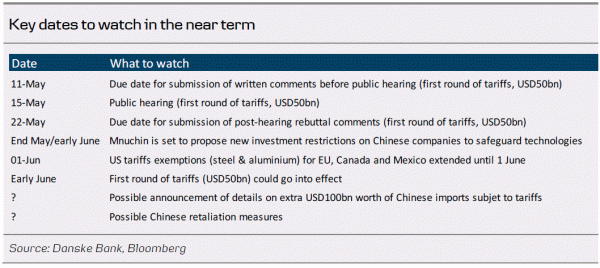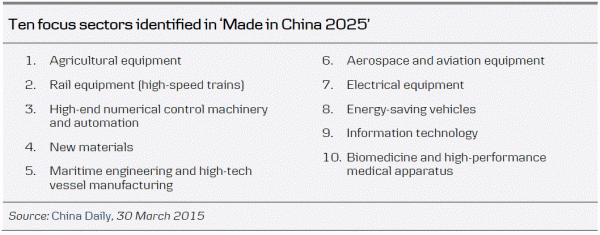Good news on the trade front
China’s top economic adviser and vice-premier Liu He is going to the US next week for further negotiations. This is a positive sign that the path of negotiation is still the preferred one after the US delegation was in Beijing last week. It is also positive that the US chief negotiator is Treasury Secretary Stephen Mnuchin as he is the more moderate voice in the US trade delegation, which also consists of the trade hawks Peter Navarro, Robert Lighthizer and Wilbur Ross.
Trump’s spokeswoman Sarah Sanders said yesterday ‘The president has a great relationship with President Xi and we are working on something we think will be great for everybody. China’s top economic adviser, the vice premier, will be coming here next week to continue the discussions with the president’s economic team. We will keep you posted as the discussions are ongoing.’ See Bloomberg, Xi and Trump to Talk Trade, Korea as Chinese Aide Heads to U.S., 7 May 2018, and FT (paywall), China’s vice-premier DC-bound for trade talks, 8 May 2018, for more on the story.
Our take: tough talks ahead
These are still going to be tough negotiations as there are key areas where US demands are unlikely to be met. Bloomberg presented a list of demands from each side here: Here’s What the U.S., China Demanded of Each Other on Trade, 4 May 2018.
The ‘Made-in-China 2025’ strategy focusing on technology and innovation is non-negotiable for China as this is the core part of their development strategy. Technology is the big area of tension. The US has already tightened significantly on Chinese investments into the US and will probably create further restrictions in this area going forward (we still await a report on this in early June). The US may also put more restrictions on US exports of technology products to China, on top of putting tariffs on Chinese tech products – as already announced recently.
Reducing the US trade deficit by USD200bn as the US has demanded is also not realistic. China will also work to increase imports but cannot put a specific number on it. They also see the deficit partly as a reflection of very low savings in the US – which will probably decrease further with the rising budget deficit (lower public savings) in coming years. China also sees the trade deficit as over-estimated because China is often at the end of the global supply chain assembling parts imported from around the world. But the full value of the product is counted as Chinese exports.
However, in the area of protection of intellectual property rights China is likely to meet the US. China has already done a lot in the past years (see for example The Diplomat: How China is Emerging as a Leader in Global Innovation and IP Rights, 7 July 2017). It has been a central part of the policy to strengthen IPR protection as China’s innovation agenda would get nowhere without this. Many Chinese companies have also complained about violations of property rights, with China now leading in the area of global patent applications, see IP Watchdog, 12 December 2017.
China will also open up more for inbound direct investments as demanded by the US. A series of initiatives have already been announced, opening up for example in the financial sector and in the manufacture of autos and aviation.
Finally, China has announced that tariffs will be cut for cars and some other consumer goods.
The question is, how many of the Chinese demands will be met? Many of these are within the area of access to technology investments and as noted above it seems very unlikely, the US is going to give anything here.
Next week, Republican Marco Rubio has announced he will introduce the Fair Trade With China Enforcement Act, which, as he writes in the Washington Post, Targeting China’s tools of aggression, 2 May 2018, among other things will ‘guard the American people against China’s nefarious influence on national and economic security, directly targeting China’s tools of economic aggression. The legislation will ban the sale of all sensitive technology or intellectual property to Chinese entities…’. A range of other protectionist measures are also mentioned, especially in the tech area.
Where to go? More protectionism but no trade war
The negotiations will likely take some time but the ultimate outcome will most likely be one of more US protectionism towards China, focusing on tech products, and other goods within the sectors mentioned in the ‘Made in China 2025’ strategy, with China increasingly looking towards other regions for tech supplies while intensifying the efforts to boost its own production of key tech components. The recent US ban on selling products to the Chinese telecom equipment maker ZTE sent a clear signal that the US cannot be counted on as a secure supplier of tech components (see SCMP, ZTE ban underlines the need for China to step up its own R&D, 20 April 2018, for more on this).
However, while we will probably end up with more US protectionism towards China, our baseline scenario is still that a tit-for-tat trade war with continued escalation will be avoided. The latest signs of negotiations underpin our expectations of this. US Trade Representative hinted in connection with the trip to Beijing last week that negotiations could take up to a year, so we should not expect a rapid resolve of the matter.














